- Share via
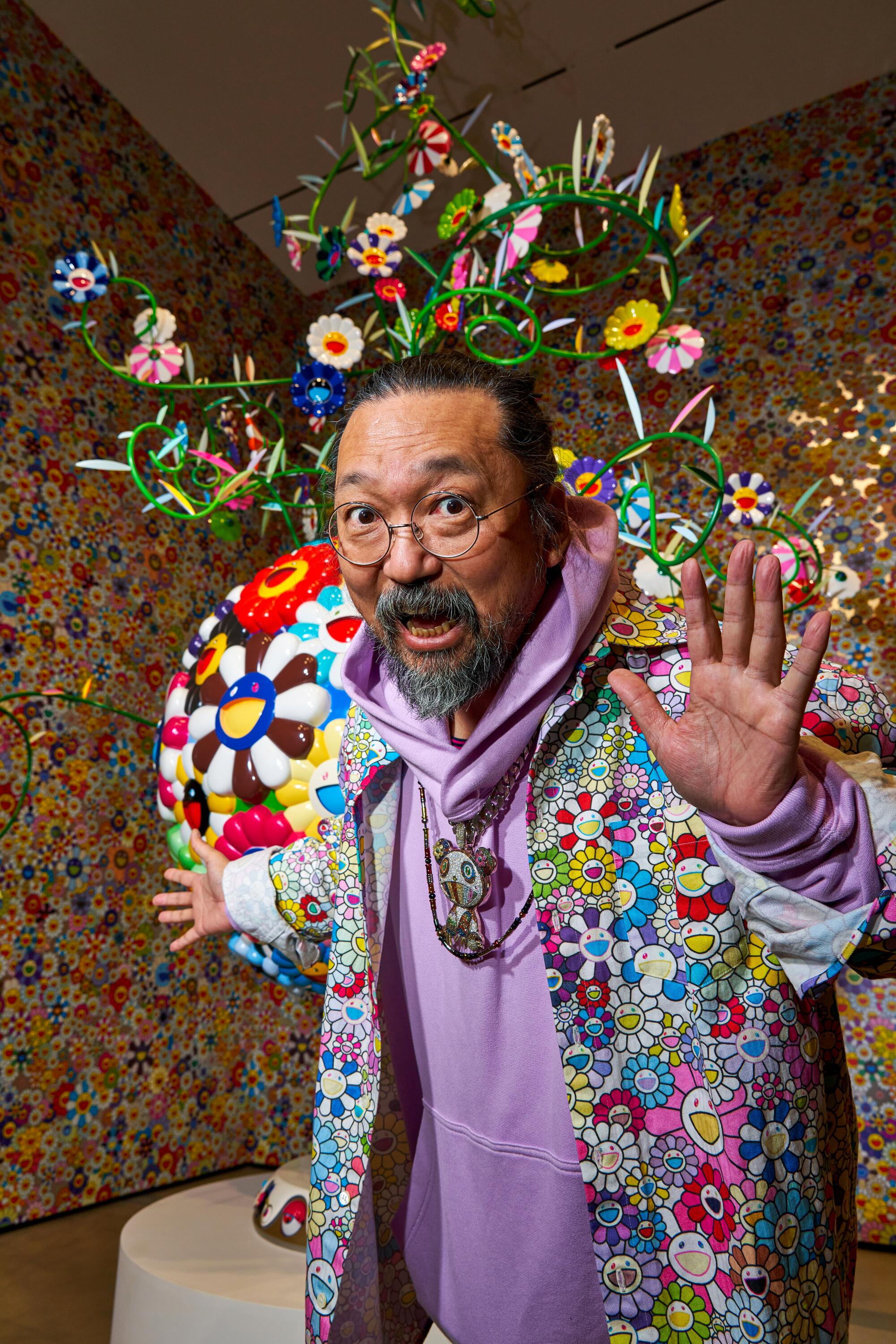
Takashi Murakami is awash in a blizzard of beaming, multicolored flowers. He’s walking along an outdoor corridor under the Broad museum’s architectural shell and the manic-looking flowers swarm through the air in his direction. They hover above his head, blinking at the artist.
Dressed in a cotton jacket flush with his iconic flower pattern, Murakami blends right into the colorful blooms. He’s testing out his new augmented reality project, viewing the imagery through his phone’s screen. The AR work — one of six that Murakami created in collaboration with Instagram, Meta’s Spark AR, the digital design studio Buck and the Broad — is part of a new Broad museum exhibition, “Takashi Murakami: Stepping on the Tail of a Rainbow,” which opened Saturday. The exhibition is Murakami’s first solo show at the museum.
Just days before the exhibition opens, the Japan-based artist is seeing the AR installation on-site for the first time.
“Oh my God, sugoi [amazing],” he says, moving along the sidewalk, his arm outstretched and phone held high in the air. He pivots side to side, viewing the work from different angles. As he does, the AR flowers — which appear in 3-D on his screen — soar and appear to cackle, a canopy of candy-colored friendliness.
“Wow,” he says. “Wow-wow-wow-wow-wow.”
It’s a happy scene until, maybe, it’s not. The flowers are so stridently cheerful, it’s almost anxiety-producing. Which makes sense. Murakami’s work — colorful, poppy imagery inspired by Japanese manga, anime and a range of other pop cultural influences and historical art references — is brimming with darker undertones that belie the work’s lighthearted surface. Much of it speaks to global disasters and widespread trauma: His recurring mushroom imagery, rendered in an illustrative manga style, references mushroom clouds, a response to the 1945 Hiroshima and Nagasaki atomic bombings in Japan.
These days, Murakami’s work has been concerned with the COVID-19 pandemic. This trip to L.A., with a stop last week in New York, is the artist’s first time outside of Japan since early 2020. He spent the first few pandemic years living and working in his studio in Japan’s Saitama prefecture, north of Tokyo. It was a period marked by global tragedy and personal challenges. His company, Kaikai Kiki, nearly went bankrupt (it didn’t), long-planned gallery and museum shows were postponed, and his sci-fi feature film, “Jellyfish Eyes Part 2: Mahashankh,” was canceled. A friend, the fashion designer Virgil Abloh, passed away, as did his father in late 2021.
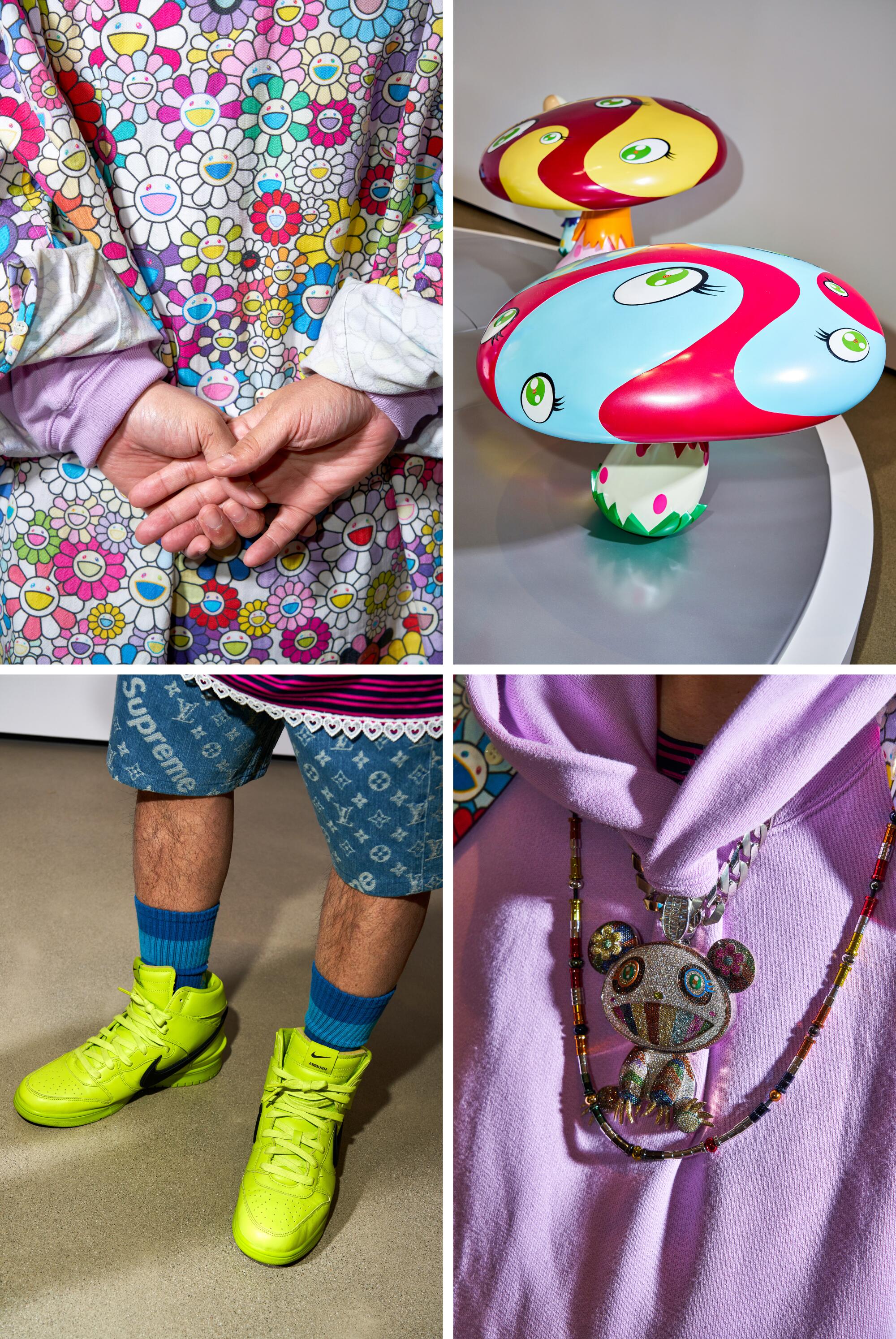
Murakami hunkered down and made art, all while noticing how people across the world had become increasingly dependent on digital platforms — shopping and socializing online, working on Zoom. The realization sparked a mounting interest in digital art and spaces. The metaverse, digital environments visitors can inhabit, often accessed with a VR headset or other technology (specifically for gaming and other forms of interactive entertainment), had become an outlet for people’s energy, with ritualized activities around storytelling helping participants make sense of the world and facilitating social cohesion. It was not unlike a modern-day religion, in his view.
Murakami’s work is also about creative transformation in the wake of crisis. So it’s no surprise that he’s now emerging in this late stage of the pandemic with new work, both a physical painting and a foray into augmented reality and other digital realms. In addition to the Broad exhibition’s AR elements, there’s also a Gagosian Gallery show that debuted in New York last week that includes AR, virtual reality and NFT influences.
The Broad exhibition includes all of the museum’s 12 Murakami holdings as well as six loans — 18 works in all. On view are key paintings, sculptures and immersive environments from different points in his career. There’s the iconic, 1999 sculptural installation depicting Murakami’s alter ego amid magical-looking mushrooms, “DOB in the Strange Forest (Blue DOB),” a wall scroll collaboration with fashion house Louis Vuitton from 2003 and an entire wallpapered room engulfing two flower paintings and a flowering plant-like sculpture, “Flower Matango (b)” (2001-2006), which has never been shown at the museum before.
Two of the AR activations appear outside and passersby can view one of them, on the Broad’s plaza, without a museum reservation. Two appear in the lobby and two appear in a gallery inside the ticketed exhibition. Visitors scan a QR code on the floor, which opens the Instagram filter through which they can view the work. A second scan of the same QR code launches the actual AR image in the appropriate museum location.
As a Broad employee explains this while we stand in the lobby, two enormous portals suddenly open on a nearby wall — the AR work as seen through her phone screen. Sci-fi-like demons stand in each one, shirtless and wielding clubs. They’re guarding the Murakami works inside the gallery. An AR version of Murakami and his beloved dog, Pom, greet visitors at the exhibition entrance.
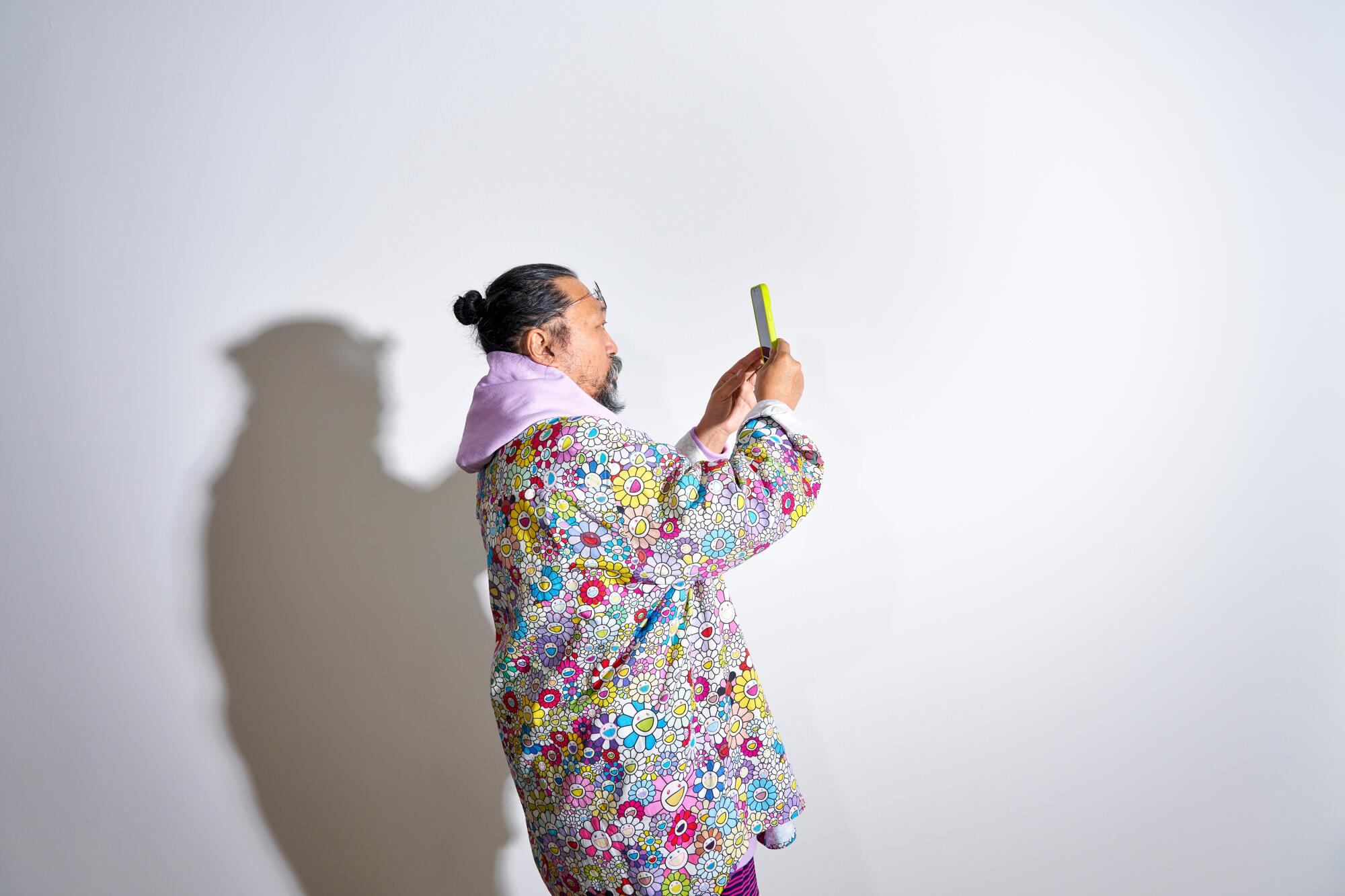
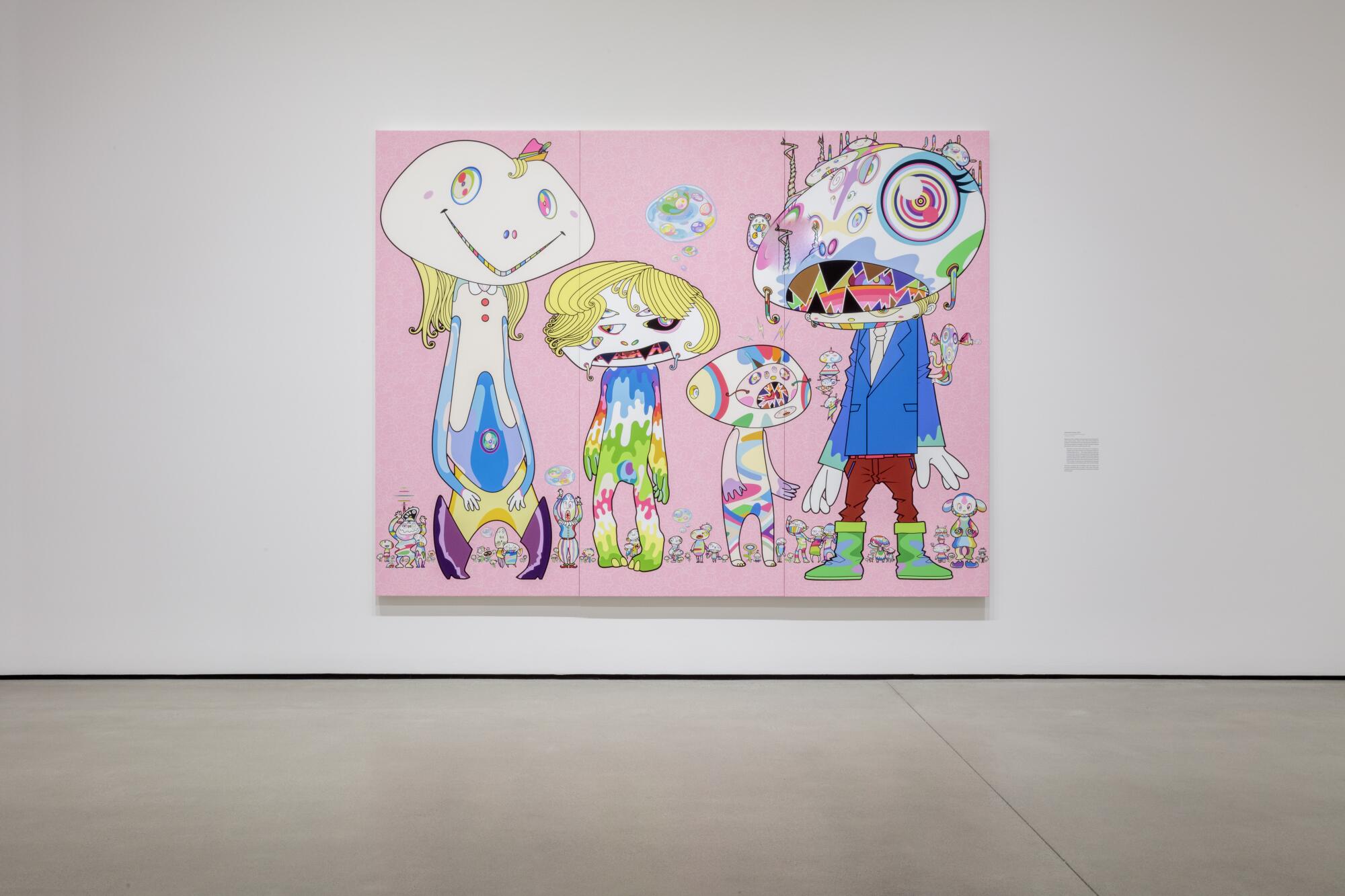
A focal point of the show is the gallery of works that depict natural disasters in conversation with one another. In it, earlier Murakami works are juxtaposed against the first painting he created for a new 2022 series; the Broad show is its worldwide debut. The show’s titular 2014 painting, “In the Land of the Dead, Stepping on the Tail of a Rainbow” — the largest work in the Broad’s collection — is an 82-foot-wide piece responding to a series of 2011 natural disasters in Japan, including the Tōhoku earthquake, tsunami, and Fukushima nuclear disaster, through the lens of Asian folklore and Daoist immortals. A coagulation of dark skulls and a ship rollicked by waves swirl within a catastrophic water event that eventually simmers at the far end into a pastoral calm.
The Buddhist-enlightened Arhats, mythological figures, populate Murakami’s nearby “100 Arhats” (2013), a painstakingly detailed and colorful work that’s also a response to those same 2011 disasters in Japan.
Catty-corner to both of those works is Murakami’s newest painting, “Unfamiliar People,” which is a direct response to the COVID-19 pandemic and how his perceptions of people he thought he knew changed during that time. Dark undersides and “internal, complex dogma and struggles” were revealed. It depicts new anime-inspired characters, zombie-like with open mouths and jagged teeth, against a bright pink backdrop. Flowers and skulls float in the background. The attentiveness to mouths in the painting is at once suggestive of the spread of infection and spewing of misinformation related to the pandemic.
“He followed people on social media [during the pandemic], and people he’d known for decades, all of the sudden, would surprise him, whether they were railing against the government over taxes or were anti-vaxxers or they would refuse to wear masks,” exhibition curator Ed Schad says. “Those moments on social media, when he was inside the computer, this series is about that. It’s about transformation.”
When asked how the pandemic changed him personally, Murakami motions to the painting. “That’s the change,” he says. “I traveled less, so I produced a lot more work.”
He points out the noticeably different color palettes between the older works in the room and the newer painting, the former composed of primary colors and jewel tones accentuated by black and brown, the new work rendered in cotton candy pink, bright blue and lemon yellow. It’s like the difference between jazz and electric pop, he says.
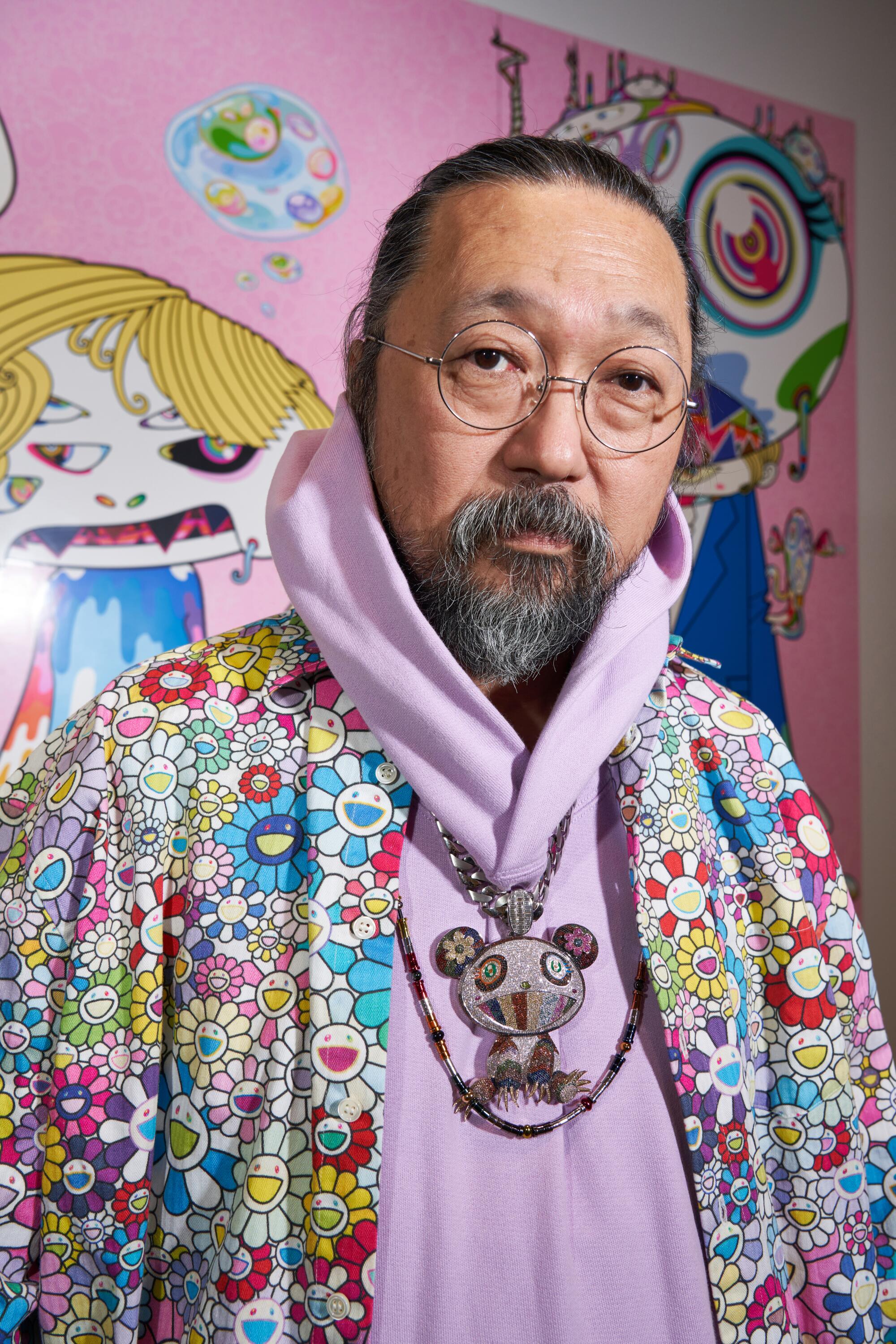
Standing in front of “Unfamiliar People,” Murakami appears both excited and a bit nervous. The painting’s debut is a big deal, he admits. When asked to elaborate as to why, he simply nods to the piece, then lets out an audible sigh. It’s part trepidation, perhaps, and part satisfaction upon finally releasing a new, monumental work into the world. Designs for a second painting in the series, he says, are underway in his studio.
Murakami points his phone at the canvas as if to snap a photo. Suddenly, two holes open up on the floor in front of it, as seen on his phone, and two silver avatars rise from beneath the floor. They are the AR versions of early Murakami characters, Hiropon and My Lonesome Cowboy. They wear futuristic bodysuits, with My Lonesome Cowboy’s hair sculpted into spikes and Hiropon donning giant, Princess Leia-like buns.
Murakami’s interest in the metaverse during the pandemic accelerated while watching his son and daughter, 11 and 8 years old, respectively, play the Nintendo video game “Animal Crossing: New Horizons.” His daughter was admiring fireworks in the game, while chatting with friends over Zoom one day. Their visceral response to the beauty in the game helped crystallize for him how the digital world, for their generation, is an actual place. It was a “cognitive revolution,” he says.
“A different world had arrived. That’s when I first felt the presence of the metaverse.”
AR is a natural progression for Murakami. So much of his work is about material transformations — the flowers, drawn from traditional Japanese painting, began as works on canvas and are now more ubiquitous than Andy Warhol’s soup cans, reproduced globally as pillows, socks, even pancake griddles. In their newest iteration, as AR, they are ephemeral.
“It’s the next step,” Schad says. “He’s moving physical objects into the metaverse world.”
Murakami hopes the interactive AR works draw in new audiences, both to his work and art history.
“My works have a lot of Asian themes and may not be too familiar to Western audiences,” he says, “and I thought the AR in this room could be a hook. [People] may want to research more online.”
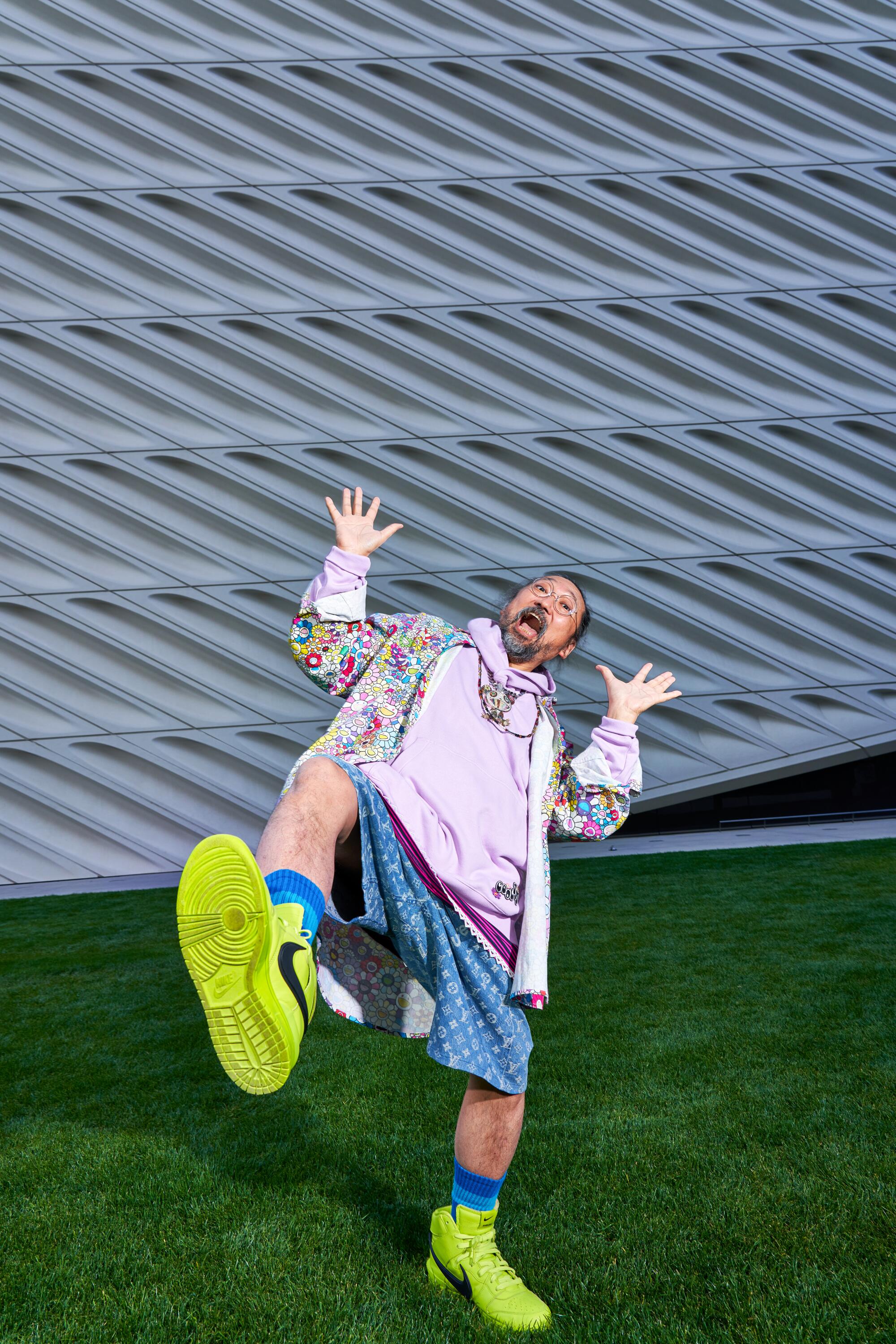
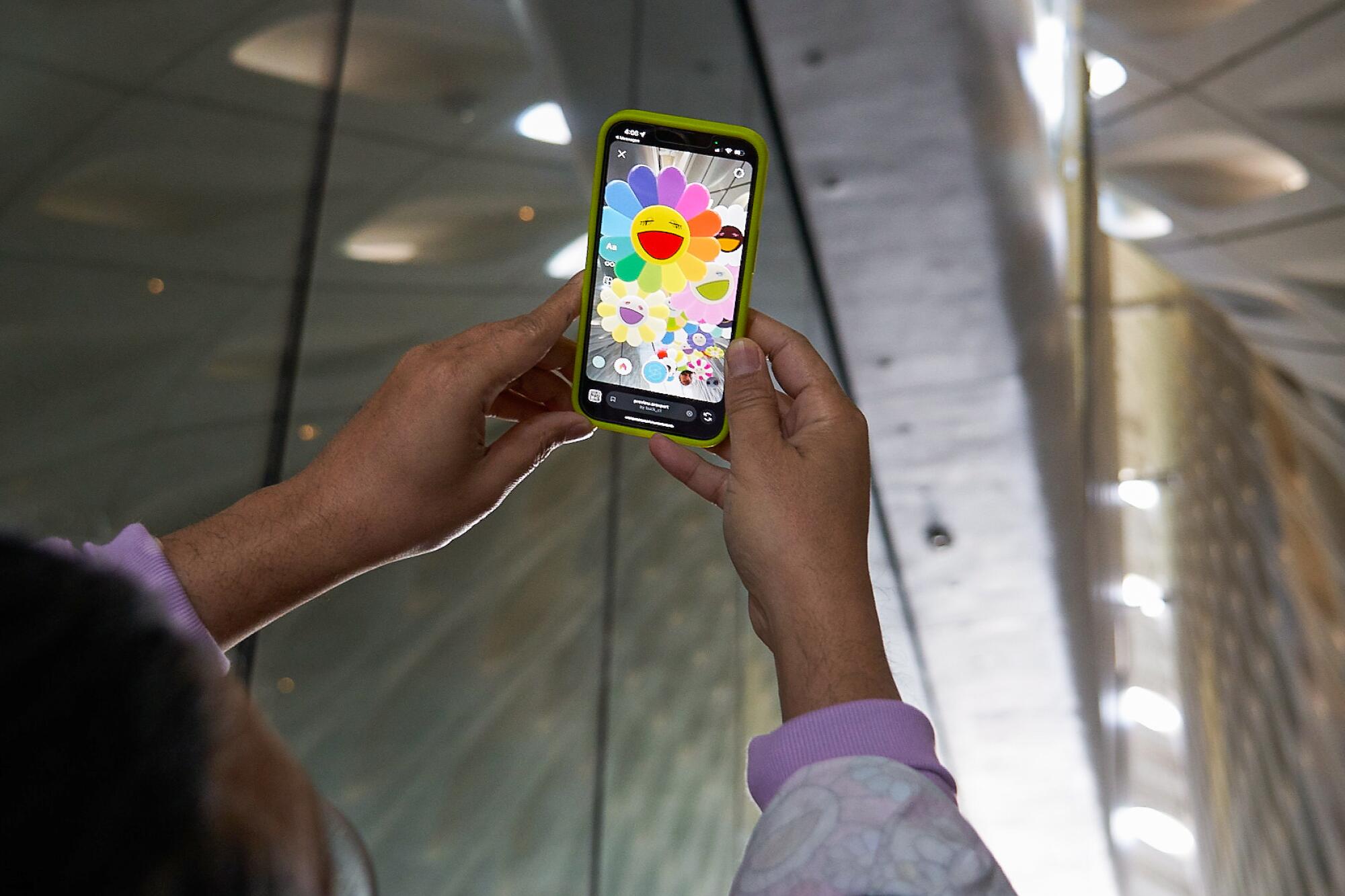
Many of the works in the show speak to themes of beauty and healing, as well as how catastrophic events often trigger creativity, bonding and resilience. In that sense, “Stepping on the Tail of a Rainbow” may be the ideal show for the moment we’re in — it’s both about crisis and offers an uplifting antidote to its stresses.
“Trauma is very important to the understanding of life,” Murakami says. “Maybe in the near future, when I am making my pieces, it’s with the message to young people: ‘life is hell.’”
He takes one last look at the new painting, the AR avatars gliding ever closer and closer.
“Understanding this, then people can [find] freedom: ‘Oh, I am not alone.’”
And with that, Murakami exits the museum and joins an AR version of his alter ego, Mr. DOB, who’s floating on a cloud above the Broad’s plaza lawn. The AR flowers swirl around him, the metaverse alive with activity. The joy it sparks on Murakami’s face is very much real.
More to Read
The biggest entertainment stories
Get our big stories about Hollywood, film, television, music, arts, culture and more right in your inbox as soon as they publish.
You may occasionally receive promotional content from the Los Angeles Times.










